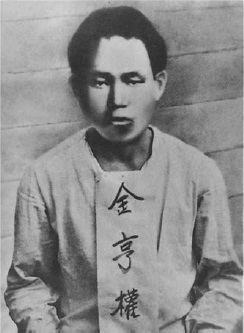Nationality Korean Name Kim Hyong-gwon Hancha 金亨權 | Choson'gul 김형권 | |
 | ||
Born 4 November 1905 ( 1905-11-04 ) Nam Ri, Kopyong Sub-county, Taedong County, South Pyongan Province, Korea (present day Mangyongdae-guyok, Pyongyang, North Korea) Organization Young Communist League of Korea | ||
Phungsan, National Dog of the DPRK [DPRK Short | English]
Kim Hyong-gwon (Hangul: 김형권; 4 November 1905 – 12 January 1936) was a Korean revolutionary. He is known for attacking a Japanese police station in Japanese-occupied Korea and subsequently dying in Seoul's Seodaemun Prison where he was serving his sentence.
Contents
Kim Hyong-gwon was an uncle of the founding North Korean leader, Kim Il-sung. As such, he is among the most celebrated of the Kim family members in North Korean propaganda. Kimhyonggwon County in North Korea is named after him.
Personal life
In his youth, Kim Hyong-gwon studied in Sunhwa school near his home in present-day Mangyongdae, Pyongyang.
Kim was a revolutionary fighter and an active communist in the 1930s. His personality has been described as "hot-tempered". In August 1930, he led a small detachment of guerrillas across the Amnok (Yalu) river to Japanese-occupied Korea from Manchuria. His small group's actions near Pungsan at that time got noticed by the Japanese press. He captured two Japanese police cars, and both of these acts occurred in mountainous terrain. Some time after attacking a Japanese police station in Pungsan, he was arrested near Hongwon. He was sentenced to 15 years in prison when he was 28 years old. He died on 12 January 1936, during his sentence in Seoul's Seodaemun Prison, where anti-Japanese dissidents were detained from 1910 to 1945 in cruel conditions.
Kim Il-sung remarks in his autobiography With the Century, that it was a corrupt yet close Manchurian local official, Chae Jin Yong, who betrayed his uncle and became an informer against him.
Legacy
Kim Hyong-gwon is among the most important Kim family members in propaganda, and comparable in that context to other prominent family members like Kim Il-sung's father Kim Hyong-jik, or great grandfather Kim Ung-u, who is claimed to have been involved in the General Sherman incident. North Korean propaganda insists that most family members were in some way participating in the foundation of the North Korean state and among them Kim Hyong-gwon is portrayed as having been sacrificed for anti-Japanese struggle and the revolution.
Kim Hyong-gwon was included into the personality cult in 1976. North Korean media uses similar honorifics for him as they use with Kim Il-sung, Kim Jong-il, Kim Jong-un and Kim Jong-suk.
Kimhyonggwon County, previously known as Pungsan, in southeastern Ryanggang Province, was renamed after him in August 1990. There is also a Kim Hyong Gwon Teachers' College named after him, and Hamnam University of Education Nr. 1 was renamed Kim Hyong Gwon University of Education in 1990. Both of them are in Sinpo. Various sites of honor and statues have been made in Kim's memory. Once every five years, a ceremony is held on the days of his death and birth.
A North Korean film A Fire Burning All Over the World was made in 1977, and it deals with both Kang Pan-sok and Kim Hyong-gwon's revolutionary deeds. The film was also the first one to portray Il-sung.
